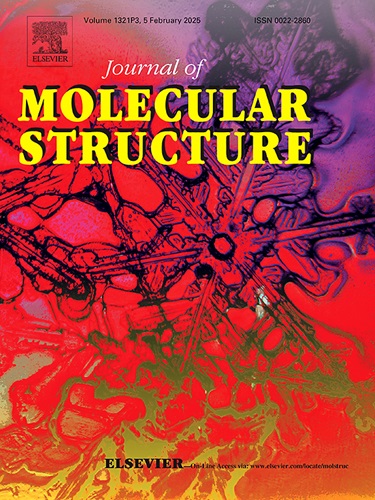Tetra-Pr3+-Incorporated Tellurotungstate Covalently Modified by d-methionine: Proton Conduction and Photochromic Properties
IF 4
2区 化学
Q2 CHEMISTRY, PHYSICAL
引用次数: 0
Abstract
A neoteric tetra-Ln3+-incorporated d-methionine covalently modified tellurotungstate NaH15{[Te4W44O151(OH)2(H2O)4(D-met)2][Pr2(H2O)8(D-met)]2}·54H2O (D-met = d-methionine) (1) was fabricated by one-pot self-assembly method. The architecture of compound 1 can be described as four [TeW9O33]8– fragments encapsulating a [W8O19(OH)2Pr4(H2O)20(D-met)4]16+ cluster. It is worth mentioning that the organic ligand d-methionine was directly covalently modified on the POM framework, connecting the W atom center. The alternating current electrochemical impedance spectroscopy (AC-EIS) demonstrated that the conductivity of compound 1 reach to 1.38×10−2 S·cm−1 under optimal circumstances. Furthermore, compound 1 has also displayed quick-response photochromic property with tinting half-life periods t1/2 of 0.735 min.
d-蛋氨酸共价修饰的四聚碲酸盐:质子传导和光致变色性质
采用一锅自组装法制备了新型四ln3 +包合d-蛋氨酸共价修饰碲钨酸盐NaH15{[Te4W44O151(OH)2(H2O)4(D-met)2][Pr2(H2O)8(D-met)]2}·54H2O (D-met = d-蛋氨酸)(1)。化合物1的结构可以描述为四个[TeW9O33]8 -片段封装了一个[W8O19(OH)2Pr4(H2O)20(D-met)4]16+簇。值得一提的是,有机配体d-蛋氨酸被直接共价修饰在POM框架上,连接W原子中心。交流阻抗谱(AC-EIS)表明,在最佳条件下,化合物1的电导率可达1.38×10−2 S·cm−1。此外,化合物1还表现出快速响应的光致变色性质,着色半衰期t1/2为0.735 min。
本文章由计算机程序翻译,如有差异,请以英文原文为准。
求助全文
约1分钟内获得全文
求助全文
来源期刊

Journal of Molecular Structure
化学-物理化学
CiteScore
7.10
自引率
15.80%
发文量
2384
审稿时长
45 days
期刊介绍:
The Journal of Molecular Structure is dedicated to the publication of full-length articles and review papers, providing important new structural information on all types of chemical species including:
• Stable and unstable molecules in all types of environments (vapour, molecular beam, liquid, solution, liquid crystal, solid state, matrix-isolated, surface-absorbed etc.)
• Chemical intermediates
• Molecules in excited states
• Biological molecules
• Polymers.
The methods used may include any combination of spectroscopic and non-spectroscopic techniques, for example:
• Infrared spectroscopy (mid, far, near)
• Raman spectroscopy and non-linear Raman methods (CARS, etc.)
• Electronic absorption spectroscopy
• Optical rotatory dispersion and circular dichroism
• Fluorescence and phosphorescence techniques
• Electron spectroscopies (PES, XPS), EXAFS, etc.
• Microwave spectroscopy
• Electron diffraction
• NMR and ESR spectroscopies
• Mössbauer spectroscopy
• X-ray crystallography
• Charge Density Analyses
• Computational Studies (supplementing experimental methods)
We encourage publications combining theoretical and experimental approaches. The structural insights gained by the studies should be correlated with the properties, activity and/ or reactivity of the molecule under investigation and the relevance of this molecule and its implications should be discussed.
 求助内容:
求助内容: 应助结果提醒方式:
应助结果提醒方式:


